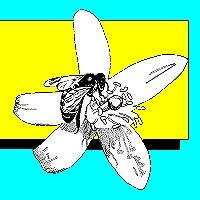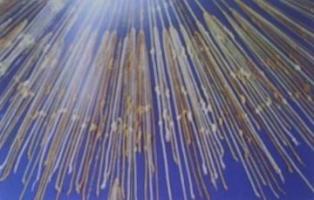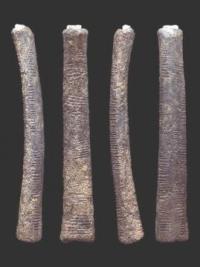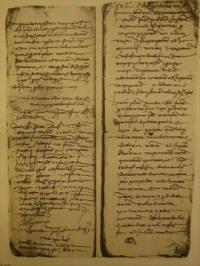APIS Volume 14, Number 11 November 1996

In this issue
- Using the Top-Bar Hive--A Kinder, Gentler Beekeeping?
- National Bee Meetings
- General Mills Help Save the Honey Bee Campaign
USING THE TOP-BAR HIVE--A KINDER, GENTLER BEEKEEPING?
The Florida State Beekeepers Association meeting this November featured Dr. Wyatt Mangum, who is finishing his graduate training at North Carolina State University. He did something few thought possible. He was able to hold the attention of an audience of committed Langstroth hive fans while describing his experiences with the top-bar hive (TBH) beekeeping. At first glance, this kind of presentation might only be thought appropriate for those in developmental apiculture who work with persons that have few resources to put into beekeeping. The TBH has always been considered a cut below the standard Langstroth hive technology now in place in most areas, especially where beekeeping is a large-scale business. In spite of this, however, I can report that Dr. Mangum's remarks were well received. It seems they appealed to the experimenter and tinkerer that seems to inhabit every beekeeper.
Dr. Mangum prefaced his remarks by saying that the TBH is well designed for what he wants to do in beekeeping. So almost all of his equipment is now in this format. The hive is inexpensive and can be made out of scrap lumber, perfect for a struggling young academician. It is also a flexible system. Dr. Mangum described reducing his larger hives to decrease their weight by simply using a buck saw to cut several bars off the end. He then converted the cut end to a queen-rearing nucleus. This is perhaps the ultimate in hive flexibility. Imagine taking a standard Langstroth 10-frame hive and converting it to an eight-frame model with a nucleus left over in the bargain.
Although Dr. Mangum does a lot of queen rearing for which his TBHs are uniquely suited, he also loads these hives in the back of his pickup truck and takes them on the road to pollination contracts. He contends that in spite of his fears to the contrary, they typically suffer little damage during transport.
TBH beekeeping is easier on both bees and beekeeper, according to Dr. Mangum. The brood is generally placed toward the front-entrance end of the hive and the honey is located in the rear. Thus, examining the brood or taking off honey is less stressful on the insects, because one doesn't have to dismantle the whole colony. The top bars butt against each other. Because of this they double as a cover, reducing material requirements and conserving weight. An outer cover of tin or cardboard is necessary, however, to protect the colony from moisture. Only the part of the hive being worked is exposed during manipulation, which reduces overall defensiveness. Finally, all his hives are mounted on stands at waist level, keeping Dr. Mangum from having to continually bend over.
Others also are doing this kind of beekeeping. James D. Satterfield (e-mail: jsatt@gsu.edu) of Canton, Georgia, says he'll never go back to Langstroth equipment. Mr. Satterfield is contemplating developing a World Wide Web home page dedicated to this technology. Another aficionado is Joel Govostes at Cornell University (e- mail: jwg6@cornell.edu), who said in a message to the Bee-L discussion list on November 8, 1996:
"I would recommend...anyone...try one of these hives out, as it is a real education, enjoyable and fascinating, observing the colony nest construction and growth `au natural.' Inspecting the hives is easy, and doesn't require much protection, normally. It is not as intrusive as taking apart a multi-story standard hive. The bees tend to just keep going about their business. Harvesting is easy with these hives (just cut the honeycombs from the top bars, leaving a little leftover to serve as a guide for the new combs)."
A history of the this technology was provided by Conrad Berube in "The Kenya Top-Bar Hive as a Better Hive in Developing Countries," American Bee Journal, August 1989, also found on his world wide web site (http://pinc.com/~bwarner/ktbh.htm) . This URL also links to a graphic of plans for such a hive. The top-bar hive is at once more ancient, and one-hundred-years more modern, than Langstroth's, according to Mr. Berube, who describes the specific hive designed for the African country of Kenya, the KTBH:
"...developed along principles of certain Greek basket hives which may date back to the time of Aristotle. Its modern avatar was `invented' by J.D. Tredwell and P. Paterson in 1965 and was employed in a rural extension project directed by the University of Guelph in the 1970's. The hive is quite simple in concept. Combs are supported by bars of wood which lay across the narrow width of the trough-like hive-body. The width of each top-bar is equivalent to the natural width of a comb plus a bee-space (35 mm or 1 3/8 inches). Thus, as in the Langstroth hive, the combs are maintained at their natural spacing from one another. Unlike the Langstroth hive, however, the combs in a KTBH are supported only at the top and are not enclosed by a full frame. Honey-comb in natural nests is roughly in the shape of a "U", wider at the top than at the bottom. This shape is stable even when supported only along the top edge. The design of the KTBH (an inverted trapezoid when seen in cross-section) allows the bees to maintain the natural shape of their comb. Since this shape is stable the bees will leave a bee-space along all edges of the comb rather than connecting it to the walls of the hive. The combs can then easily be removed for manipulation or harvesting. The top-bars have the same, standard length of 480 mm. (19 in.) so that combs may be transferred into Langstroth equipment, for instance to strengthen a broodnest, for those beekeepers who maintain both types of hives."
Because the top bars can be made the same length as in the Langstroth hive, the top-bar hive can also be fitted with standard supers, taking advantage of the best of both hive technologies. Indeed, another way to describe the top-bar hive is one based on a frameless, moveable comb.
Most questions about the top-bar hive concern the number of bars in a colony and the slope of the sides (at least one practitioner says there is minimal attachment even if there is no slope). The actual figures depend on the race of honey bee in use or characteristics desired by the beekeeper. For example, the number of bars can range from 11 to 35 (400 to 1143 mm total hive length); the hive width from 356 mm to 480 mm and depth from 229 mm to 490 mm. The side slope ranges from zero to twenty-three degrees and the top-bar spacing (center to center) can be as little as 30 mm for Apis cerana or as much as 38 mm. for Apis mellifera (European). African bees average 32 mm. For more details, see Bees & Beekeeping: Science, Practice and World Resources by Eva Crane (Heinemann Newnes: 1990).
Possible disadvantages of the TBH can result from its very flexibility. Too small a hive, for example, can result in unproductive populations that may also swarm excessively. A small frame also means more handling during harvesting honey. Both of these can be modified at the beekeeper's will, however, and tailored to suit individual needs.
Use of Apistan © for Varroa control, a technology more recent than most top-bar hive designs, could pose a problem. The plastic strips are designed to be inserted between frames in the Langstroth hive, so presumably a small notch between top bars is needed to accommodate them. Some beekeepers also put notches elsewhere for ventilation in the sides of the boxes and/or in the bars themselves to give bees access to supers, should they be used.
A key issue in using the TBH is to provide the bees with a good foundation to build strong comb. This can be anything from a simple waxed string to a strip of regular foundation melted onto the middle of the top bar. Mr. Satterfield suggests immersing brown paper bags in wax and cutting them into strips to make a reinforced starter strip. A maximum of one-half inch is suggested. If it is too large, comb distortion can result. A final advantage is that the comb is built according to the nature of the bees themselves. The resultant cell size, therefore, is potentially much more `natural,' (based on the bee that built it) than that constructed on wax foundation. Some believe much of what presently ails modern beekeeping is the manipulation of insect size via "artificial" foundation. After hearing Dr. Mangum and then reading more about top-bar hive technology, I realized it makes for a kinder, gentler beekeeping, perfectly suited for the urban setting. It may be just the ticket for those neophyte beekeepers I am now seeing at meetings who don't want take up beekeeping as an avocation, but would like a colony or two for educational purposes or pollinating their home garden.
NATIONAL BEE MEETINGS
This is the time of year to begin planning for the national bee meetings. The American Beekeeping Federation is convening in Norfolk, Virginia at the Omni Waterside Hotel January 15 through 18, 1997. A special add-on event is a symposium to educate beekeepers about commercial pollination as an enterprise. For information on the meeting, contact Secretary-Treasurer Mr. Troy Fore, Jr., P.O. Box 1038, Jesup, GA 31598, ph/fax 912/427-8447.
Billed as a "mega bee meeting," the American Honey Producers Association, the Apiary Inspectors of America, and the American Association of Professional Apiculturists will all meet together in Memphis, Tennessee, at the Memphis Marriott, Thousand Oaks Blvd. (800/627-3587) January 7 through 11, 1997. For information, contact, the AHPA at Route 3, Box 258, Alvin, TX 77511, ph 713/992-0802.
The annual American Bee Research Conference will also take place as part of the above Memphis meeting. Presentations are restricted to research work involving the genus Apis. Abstracts will be published as the "Proceedings of the 1997 American Bee Research Conference" in the March issue of American Bee Journal. Titles must be received by December 19, 1996 by John Harbo, Honey Bee Breeding, Genetics & Physiology Laboratory, Baton Rouge, LA 70820, ph 504/767-9288, fax 504/766-9212 or e-mail: Jharbo@asrr.arsusda.gov.
HELP SAVE THE HONEY BEE
Remember the Captain Midnight rings and other gadgets available by boxtop redemption advertized during the days when radio was king? Well, now consumers can contribute to honey bee research by doing the same thing. General Mills has launched a plan to save the honeybee through the same kind of promotion. For every Honey Nut Cheerios (R) honey bee caricature clipped from the front of the cereal box and returned to the company, General Mills will contribute 25 cents to a bee research fund. The goal is to reach $100,000, says Gene Brandi, Chairman of the American Beekeeping Federation's Research and Technical Committee.
There will be no information on cereal boxes promoting this plan, however, Mr. Brandi says, and so it will be up to the beekeeping community to spread the word. Here as some ways to help the campaign along:
- Call the Help Save the Honeybee Hotline (800/362-2006) and request a full information packet, number two on your touch-tone phone. This is one way General Mills will be judging the response to the program in order to make a decision about continuing it past its expiration date of January 31, 1997.
- Contact local newspapers, especially those that have run stories about bee losses, and get them to publicize the campaign.
- Encourage association members, schools and other groups to clip and collect the caricatures for redemption.
The redemption address is Help Save the Honeybee, P.O. Box 5450, Minneapolis, MN 55460-5450. The research money will be evenly distributed over three research centers: University of Minnesota, Michigan State University, University of California at Davis.
Malcolm T. Sanford
Bldg 970, Box 110620
University of Florida
Gainesville, FL 32611-0620
Phone (904) 392-1801, Ext. 143 FAX: 904-392-0190
http://www.ifas.ufl.edu/~entweb/apis/apis.htm
INTERNET Address: MTS@GNV.IFAS.UFL.EDU
©1996 M.T. Sanford "All Rights Reserved




















